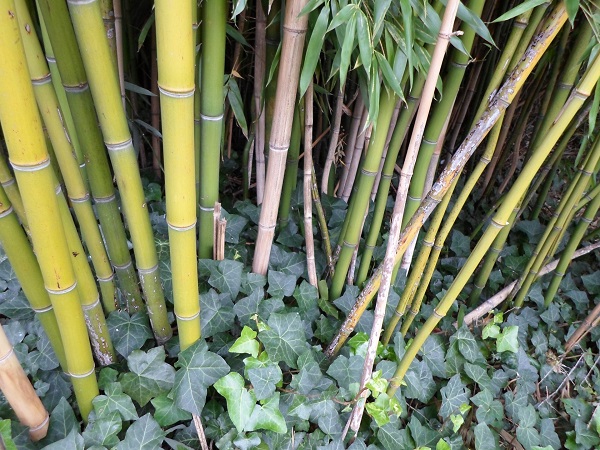
By Gregory Havel
Bamboos are a subfamily of flowering perennial evergreen plants in the grass family. (photo 1). Giant bamboos are the largest members of this family. They are the fastest growing plants in the world. Some species can grow three feet (91 cm) in 24 hours. There are more than 1,400 species of both woody and herbaceous varieties. Bamboos are found on all of the continents except for Europe and Antarctica and in climates ranging from near-arctic through temperate to tropical. Their stems are usually hollow.

(1) Photos courtesy of Alain Van den Hende.
Most bamboo that is harvested is wild, although some varieties are farmed for specific purposes. The largest of the timber bamboos can grow to nearly 100 feet in height (30.5 m) and six to eight inches (15-20 cm) in diameter. The individual stems grow from a broad rhizome (root) system in a single year, spend several year maturing and hardening, and die in five to seven years so that new stems can replace them.
Since bamboo is a perennial and an evergreen, some stems can be harvested from each clump several times each year; with a complete harvest taking five to six years. Because it is a perennial grass, it does not have to be replanted after harvest such as forest trees (photo 2). Properly processed and cured, timber bamboo is harder than oak wood.

(2)
Bamboo has been used in construction for centuries in Asia, tropical America, and Africa. Its common uses include scaffolding (similar to tube-and-coupler scaffolding, with twine lashings instead of connecting clamps); bridges; and simple residences with frames of bamboo stems and walls and roofs of split bamboo woven into mats.
Because of its fast growth, easy harvesting, and lack of needing to be replanted, bamboo is popular with modern builders and environmentalists as a “sustainable” product and as a way to reduce the carbon footprint of a construction project.
Its more recent uses in construction in Europe, the Americas, and Asia include load-bearing structural elements and decorative elements made of sawn and glue-laminated bamboo strips. Photo 3 shows a manufactured floor board made of glue-laminated bamboo strips.
RELATED: Warren on Identifying Building Construction ‖ Avillo: Respect Lightweight Construction ‖ Crimmins on Redefining Hybrid Construction
Photo 4 shows manufactured tongue-and-groove floor boards made of strips of bamboo glued and pressed together to form boards. Decorative laminated bamboo products available today include laminated flooring that is advertised to be more durable than hardwood, laminated beam and column coverings, laminated panels, and laminated planks. Although it is considered “sustainable” and “green,” adhesive laminated bamboo is combustible and burns like hardwood.
This ancient building material is in widespread use throughout the world, and we are finding new uses for it. Some of these uses will replace traditional materials with bamboo laminates and bamboo fiber. When these products find their way into buildings and other structures, they will have been extensively tested in laboratories and with computer simulations. The results of these tests will be used as the basis for advertising campaigns and building code changes in favor of the use of these new products. However, it may take decades to determine whether they age as well as the traditional materials that they replace and whether they remain as fire-, moisture-, rot-, and insect-resistant as the traditional materials.
In the interest of accumulating this information, note on our preincident plans when these products are used in a structure, and include information on their performance in our incident reports, even when there is no failure. This should not be a great burden; firefighters will respond to incidents in these buildings for the next several generations.
Download this article as a PDF HERE (336 KB)
 Gregory Havel is a member of the Town of Burlington (WI) Fire Department; retired deputy chief and training officer; and a 35-year veteran of the fire service. He is a Wisconsin-certified fire instructor II, fire officer II, and fire inspector; an adjunct instructor in fire service programs at Gateway Technical College; and safety director for Scherrer Construction Co., Inc. Havel has a bachelor’s degree from St. Norbert College; has more than 35 years of experience in facilities management and building construction; and has presented classes at FDIC.
Gregory Havel is a member of the Town of Burlington (WI) Fire Department; retired deputy chief and training officer; and a 35-year veteran of the fire service. He is a Wisconsin-certified fire instructor II, fire officer II, and fire inspector; an adjunct instructor in fire service programs at Gateway Technical College; and safety director for Scherrer Construction Co., Inc. Havel has a bachelor’s degree from St. Norbert College; has more than 35 years of experience in facilities management and building construction; and has presented classes at FDIC.
MORE CONSTRUCTION CONCERNS

